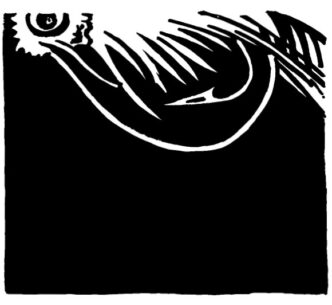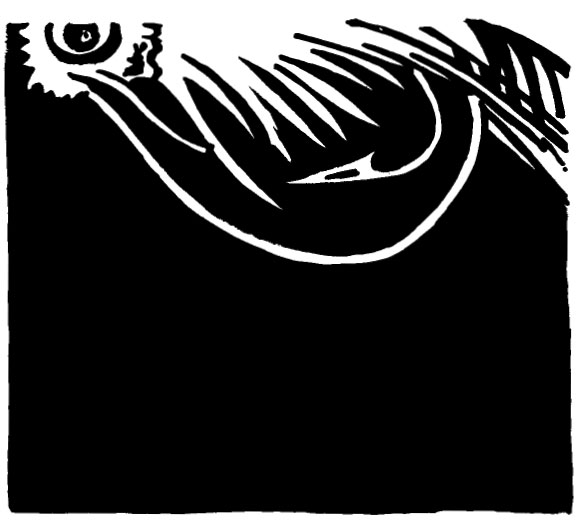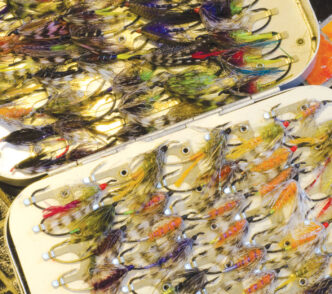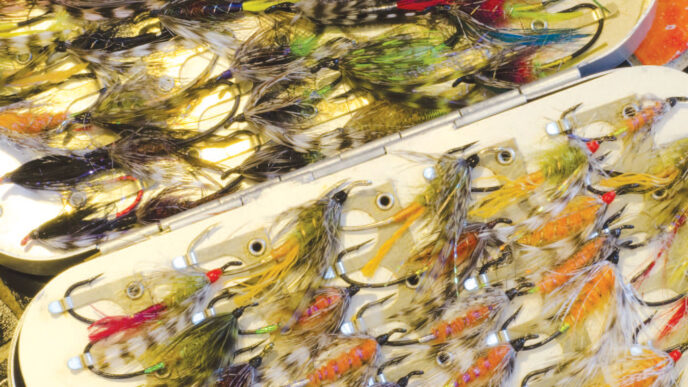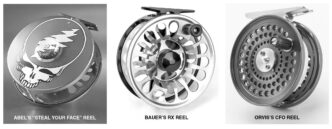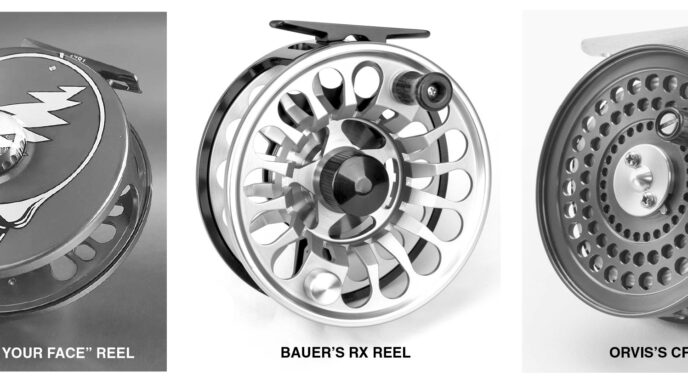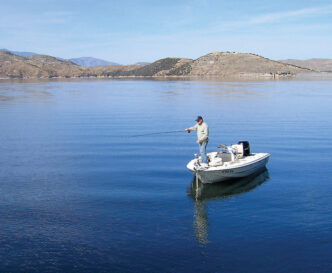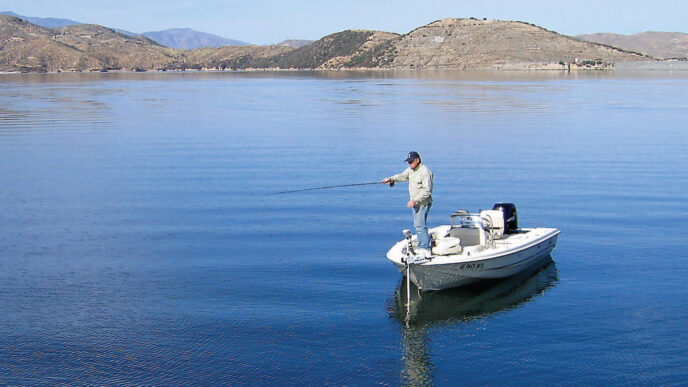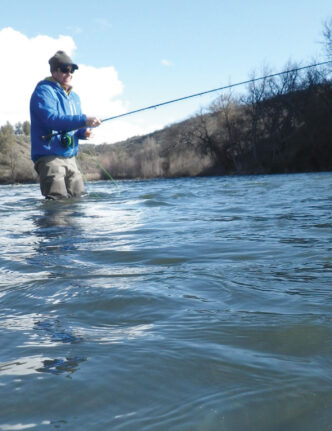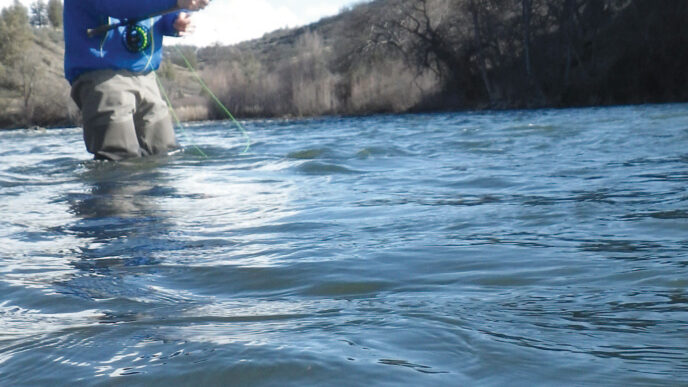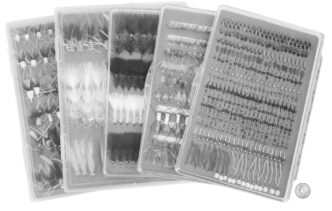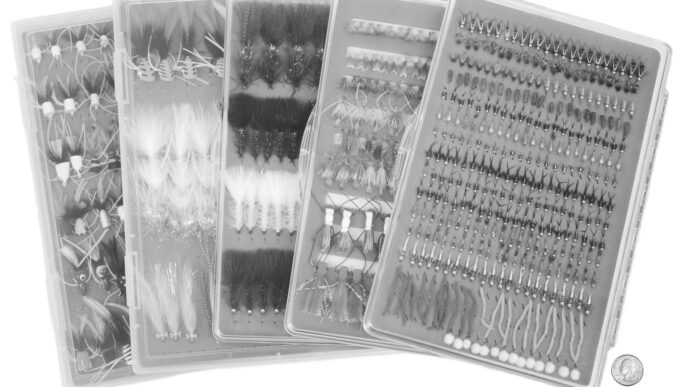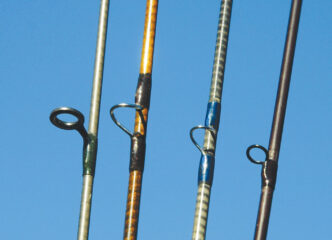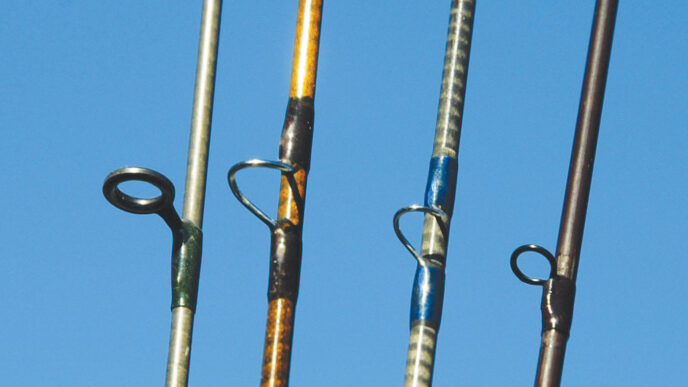Eyes — no, I’m not going to talk about painting eyes on bass bugs or using jungle cock to mimic eyes on traditional streamers. The subject is peepers, not poppers — your eyes and my eyes.
Fly fishing is a very visual sport. That’s what makes dry-fly and bass-bug fishing so much fun: you get the see the strike. Sometimes you see the fish well before the strike. Watching for the subtle shadow that exposes a trout moving across the gravel bottom of a stream or detecting the fin movements of a largemouth bass fanning its bed in the shallows is a kick, and it allows you to make the proper presentation to get that fish to bite.
Good eyesight lets you see the flicker of a school of bait as it slips through the water near your float tube. It allows you to glance across a stream and spot the flutter of caddisflies coming off in the morning sun or see hatching mayflies as they ride the current, drying their wings. You get to see that size 20 Adams as it turns over and drops to the surface of dappled light and shadow.
Well, that’s the way it’s supposed to be. When I was a bit younger, say about 30 years ago, I could do all of these things without any optical aid. I was blessed with better than 20-20 vision. When I entered the navy, the guy who checked my eyes told me I should apply for pilot training. (I didn’t, but that’s another story.)
Things change. At about age 40, I found I needed a bit of magnification to read comfortably. Either that, or my arms were getting shorter. Glasses didn’t feel all that strange, because I wore military-style sunglasses outside and often safety glasses inside, and the extra bit of help to my vision was great. In a few more years, both my close vision and distance vision needed a boost, and I wound up with bifocal glasses. Now I need both corrective glasses and additional magnification to deal with a 5X tippet and the eye of a typical dry fly.
Don’t pity me — things could be a lot worse. Don’t laugh, either, because it’s likely to happen to you, too. One of the bass guys I fish with turned 75 this year and still doesn’t need glasses. On the other hand, lots of men and women in their 30s are wearing prescription glasses or contacts. Many others are getting laser surgery to correct their vision.
The absolute first thing the fly angler needs — even with 20-20 vision — is sunglasses. A day spent on the water without eye protection is just miserable. The effect is a lot like having your eyes poached like an egg. It hurts, leaving you with a splitting headache at the end of the day and, even more important, you can suffer longterm damage to your eyes.
Ultraviolet light causes a number of not so nice changes to your eyes over the long haul, including cataracts. People with light-colored eyes (blue or green) appear to be more at risk, but even if you have dark eyes, why take any chances?
If you’ve been fishing for very long, you probably already know that polarized sunglasses with enhanced ultraviolet protection are the proper solution. By viewing the world with polarized light, you kill most of the surface glare off the water and get a much better look into the subsurface world. I tried fishing with those old military sunglasses of mine for a couple of years, mainly because they were high-quality glass instead of plastic, but I soon realized that the better vision provided by even cheap plastic polarized sunglasses was more effective.
These days, you can find dozens of polarized sunglasses in a variety of styles and lens colors. I haven’t tried the copper shade that some manufacturers are touting now, but I have tried and have liked both gray and amber lenses for fishing on streams. Gray seems to do better for me when bass fishing on still waters. If you are flush with spare cash, you can carry both colors, using the darker, gray shades during the day and switching to amber when light levels are low. Amber does a great job of emphasizing contrast, which is why shooters often use them in competition. The fly angler can get the same benefit on the stream or lake at dawn and dusk.
I recently had my eyes examined and a new pair of ordinary-use glasses made. I was pressed for time, so I took my new prescription to one of those places that promise “new glasses in an hour.” The reason was that at age 72, my old driver’s license was expiring, and I received a letter from the DMV that noted I needed to take a vision test, as well as a written test. To my utter astonishment, the new glasses greatly improved my close-range vision and fixed most of the problems I had started to encounter with distance vision. The effect is so remarkable that I intend to get a pair of polarized prescription sunglasses just for fishing.
If your vision is otherwise good, a quality pair of polarized sunglasses is just about all you’ll need. Most anglers put a neck strap on their glasses. With the ever-changing light conditions you face while fishing, you’ll probably put on and take off your sunglasses dozens of times a day. Being able to just pull them off and let them drop without losing them is a real benefit.
I’ll make a pitch here for sunglasses that have wide side frames to block off scattered light that enters from the side and reflects off the inside of the glasses. For many years, I fished with pair of polarized sunglasses that had side “skirts” about three-quarters of an inch wide, and they really cut reflected glare. The only downside is that they block some of your peripheral vision. Be extra careful if you also drive wearing these glasses.
By the way, all sunglasses perform better if you wear a hat, especially a hat with a brim that is dark on the underside. It’s a bit like the blacking that ballplayers use to kill reflections from their cheekbones. Don’t wear a black hat, though, as the heat you’ll suffer isn’t worth it. Many quality hats for anglers have darkened undersides on their brims.
You can get all kinds of polarized sunglasses in plastic lenses, and you can get most of them in glass at a higher price. Prescription sunglasses top the price list — some of these cost more than a decent fly rod. For the wearer of prescription glasses who can’t afford to shell out the cash for prescription sunglasses, though, a pair of clip-on polarized sunglasses is a good idea. There are even clip-on side shades you can add to regular glasses to improve the antiglare factor.
Even better than clip-on sunglasses are the clip-on and flip-up types. In past years, I wore inexpensive flip-up clip-ons quite a bit, preferring just to spend a few bucks for an inexpensive plastic set to go on my regular glasses. Clip-ons and flipups don’t last forever, but buying a pair or two each season is not all that costly.
There are also sunglasses available that are designed to slip on over your regular glasses. Yes, it’s wearing two pair of glasses at the same time, but it means having both eye protection in front and usually good side protection, as well, plus your regular prescription lenses. It also means having two pairs of glasses that may fall off if you don’t have them on neck straps. If you do add straps, chances are good that you’ll manage to get tangled up when you try to take them off. These “wear-over” style glasses work, but frankly, I find them uncomfortable.
Now for the magnification issue. A lot of us older anglers need that extra bit of help when tying tippets or flies on the leader and doing other tasks, both on the water and at the fly-tying bench. As my vision worsened, I tried a lot of different things to correct for the loss. The first was one of those magnifiers that attaches to the middle of a fluorescent lamp. It was effective for tying flies, but seemed to be forever getting in the way. I either bumped my nose on it or whacked it with a hand while trying to add materials and wrap thread. Sometimes I did both.
Next came a four-inch-diameter magnifier on a gooseneck stand that I could position where I wanted. That works pretty well. The one I like most is the cheapest one I could find (Harbor Freight and Tools) and has a big, spring-loaded clamp on the bottom to hold it to the edge of my fly-tying table. By adding another cheap, hand-held magnifier that I can grab when I need it, I’m able to tie as effectively as ever. Of course, now that I primarily fish for bass with my fly rods, the flies I’m tying are a lot bigger, and the materials are much easier to deal with.
The other thing that goes with adding a bit of magnification to aid your eyes is additional light. There are all kinds of lamps you can use. I try to avoid fluorescent lights and use normal incandescent bulbs. There’s something about the quality of light from a fluorescent bulb that bothers me.
If you get a crick in your neck while tying because you are constantly tilting your head back to look through the lower half of your bifocal glasses, here’s a trick you can try. A guy I used to hang around with in my street-rodbuilding days worked in a wheel-and-frame shop. He wore bifocal glasses and had a constant neck ache from working under vehicles on a hydraulic hoist.
One day, it dawned on him that it was the glasses that were causing the problem. He went to his optometrist and had a pair of work glasses made with the upper and lower prescriptions swapped. He could now work on the underside of the vehicle, looking up, without getting a crick in his neck and still glance around and see people and things at a distance through the bottom half of the glasses.
You also could get away with just having a spare pair of glasses made with your close-up prescription across the whole lens. A lot of people do this for working at the computer, just asking the optometrist to lengthen the focal distance a bit more than they normally use to read text on a printed page. It will work well for you at the tying table, and you can add any sort of extra magnifiers you might want.
If you don’t need a particular prescription, just a bit of magnification, try those inexpensive “reading” glasses you see in drugstores. They come in a variety of magnifications, and you might well find a pair that will work just fine at the bench or on the stream. My stepson is approaching his late 40s now, and his eyes are a bit worse for wear, but he’s found a pair of reading glasses that serve his needs.
For folks like me who need both prescription glasses and a bit of extra magnification, there are a number of add-on magnifiers that will do the trick. Commonly available are the headband-style magnifiers used by mechanics, jewelers, and watch repairers. They work very well at the bench, but are not for use on the stream. One of the most popular you’ll see in tying catalogs are the MagEyes units. If you do a Google search for magnifiers, you can find headband-style magnifiers that use glass optics, but be prepared for some sticker shock — they are not inexpensive.
When on the water and fishing, you can use a separate magnifier that you carry on your person, such as from a lanyard around your neck, or that attaches to your glasses or your hat. The clip-on designs must be easily available when you want magnification and out of the way the rest of the time. One option is a pair of lenses that clips to your glasses and folds out of the way when not being used. There are also “bifocals” that cling to your sunglasses. They use static cling to stay in place. I’ve not tried these.
The other types all clip to the brim of your hat and fold down for use a couple of inches from your glasses. Most of these are made with acrylic plastic lenses and are available in a range of magnifications. Typical magnifications are 1.50, 1.75, 2.00, 2.25. Some go as high as 2.50 and 3.00. Acrylic lenses offer good to very good optical quality, but scratch easily. You can get plastic polish that will remove minor scratches, but none of the plastic lenses are as good as glass lenses for scratch resistance.
I bought a pair of the hat-brim-type clip-ons in 2.25 magnification for onstream work and was very pleased with them for a while. The optical quality was excellent. The only problem was with the acrylic material used to form the clip that went on the brim. It broke after just a few weeks of use.
At the moment, I’m using a clip-on magnifier called “Hat Eyes,” made by the same folks who make the MagEyes headband-style magnifiers. They have acrylic lenses, but the clip that secures them to the brim is stainless steel — a big improvement. They also allow you to set the spacing between the magnifying lens and your glasses, a nice touch.
No matter what brand of flip-up magnifiers you choose to use, the extra advantage of just a slight bit of magnification when you need it saves time on the water. No more fumbling around and stabbing a tippet you can’t see at a hook eye you can’t see, either. There are any number of ways to improve your vision both at the fly-tying bench and on the water. Check around, and I’m sure you’ll find something that works for you.



